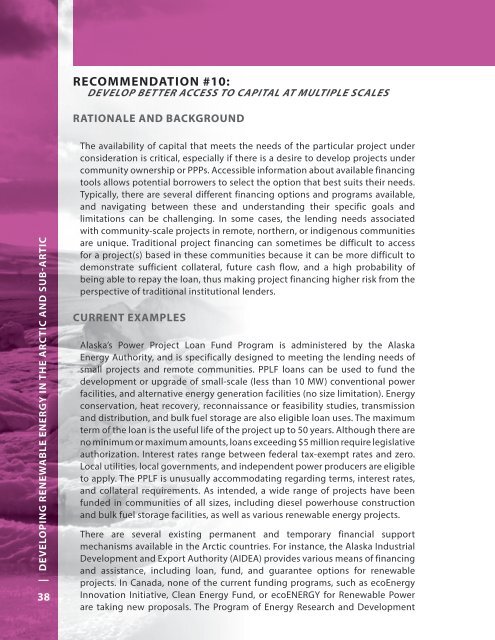DEVELOPING RENEWABLE ENERGY IN ARCTIC AND SUB-ARCTIC REGIONS AND COMMUNITIES
FulbrightArcRenewableEnergy
FulbrightArcRenewableEnergy
Create successful ePaper yourself
Turn your PDF publications into a flip-book with our unique Google optimized e-Paper software.
RECOMMENDATION #10:<br />
DEVELOP BETTER ACCESS TO CAPITAL AT MULTIPLE SCALES<br />
RATIONALE <strong>AND</strong> BACKGROUND<br />
| <strong>DEVELOP<strong>IN</strong>G</strong> <strong>RENEWABLE</strong> <strong>ENERGY</strong> <strong>IN</strong> THE <strong>ARCTIC</strong> <strong>AND</strong> <strong>SUB</strong>-ARTIC<br />
38<br />
The availability of capital that meets the needs of the particular project under<br />
consideration is critical, especially if there is a desire to develop projects under<br />
community ownership or PPPs. Accessible information about available financing<br />
tools allows potential borrowers to select the option that best suits their needs.<br />
Typically, there are several different financing options and programs available,<br />
and navigating between these and understanding their specific goals and<br />
limitations can be challenging. In some cases, the lending needs associated<br />
with community-scale projects in remote, northern, or indigenous communities<br />
are unique. Traditional project financing can sometimes be difficult to access<br />
for a project(s) based in these communities because it can be more difficult to<br />
demonstrate sufficient collateral, future cash flow, and a high probability of<br />
being able to repay the loan, thus making project financing higher risk from the<br />
perspective of traditional institutional lenders.<br />
CURRENT EXAMPLES<br />
Alaska’s Power Project Loan Fund Program is administered by the Alaska<br />
Energy Authority, and is specifically designed to meeting the lending needs of<br />
small projects and remote communities. PPLF loans can be used to fund the<br />
development or upgrade of small-scale (less than 10 MW) conventional power<br />
facilities, and alternative energy generation facilities (no size limitation). Energy<br />
conservation, heat recovery, reconnaissance or feasibility studies, transmission<br />
and distribution, and bulk fuel storage are also eligible loan uses. The maximum<br />
term of the loan is the useful life of the project up to 50 years. Although there are<br />
no minimum or maximum amounts, loans exceeding $5 million require legislative<br />
authorization. Interest rates range between federal tax-exempt rates and zero.<br />
Local utilities, local governments, and independent power producers are eligible<br />
to apply. The PPLF is unusually accommodating regarding terms, interest rates,<br />
and collateral requirements. As intended, a wide range of projects have been<br />
funded in communities of all sizes, including diesel powerhouse construction<br />
and bulk fuel storage facilities, as well as various renewable energy projects.<br />
There are several existing permanent and temporary financial support<br />
mechanisms available in the Arctic countries. For instance, the Alaska Industrial<br />
Development and Export Authority (AIDEA) provides various means of financing<br />
and assistance, including loan, fund, and guarantee options for renewable<br />
projects. In Canada, none of the current funding programs, such as ecoEnergy<br />
Innovation Initiative, Clean Energy Fund, or eco<strong>ENERGY</strong> for Renewable Power<br />
are taking new proposals. The Program of Energy Research and Development


